“Do it in ONE day only. Get in and get out.”
That’s the advice I was repeatedly given about visiting the Taj Mahal in Agra, India. People said Agra was a dirty, dusty, crowded city that didn’t warrant a visit of more than a few hours. Being a bit of a rebel, however, I was unconvinced. Instead, I booked three nights at the DoubleTree by Hilton and hopped aboard a local bus in Delhi, determined to discover the best places to visit in Agra.
In a nod to conformity, I decided to visit the Taj Mahal on my first day in Agra. A huge percentage of tourists visit this wonder of the world on day tours from Delhi. By 10 a.m., caravans of tour buses are vomiting thousands of visitors onto the grounds. Hoping to avoid the crowds and the midday heat, I planned to arrive before dawn. I scoured the list of do’s and don’ts on the official Taj Mahal website, especially noting items that were prohibited on the site. As per instructions, I removed my phone charger, headphones, anything that could be construed as a book, and extra camera batteries from my messenger bag.
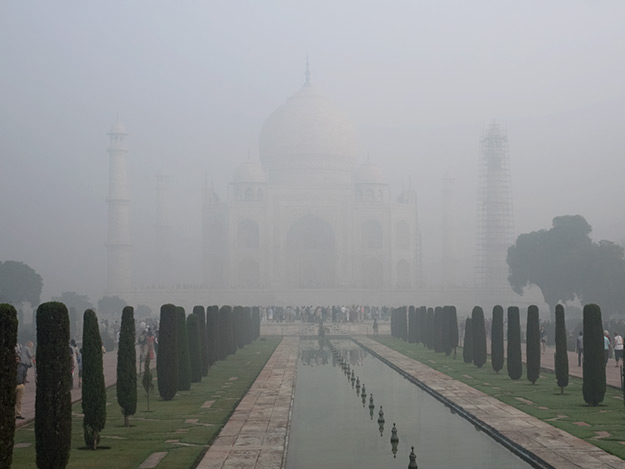
The next morning, a moto-rickshaw dropped me at the east gate at 5:45 a.m. I bought my ticket for 1,000 Rupees (about $15 USD), picked up my bottle of water and booties to cover my shoes, and walked a quarter mile to join the women’s queue. By the time stepped up to the security checkpoint 45-minutes later, the sun had risen and I was sweating profusely. I stepped through the non-functioning metal detector and opened my bag for a search. Seconds later the security guard held up my small portable flashlight and shook his head. I was promptly ushered back outside. Fortunately, a kind-hearted shop owner offered to keep it for me. I dashed inside once again and managed to talk my way to the head of the line rather than waiting another hour.
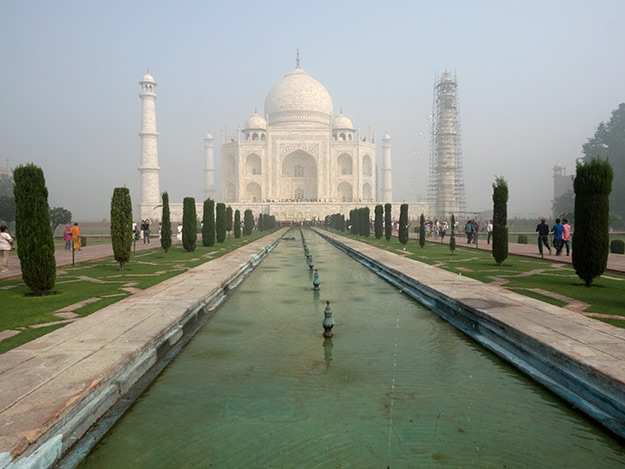
Even with the long delay, I’d beaten the tour buses. Hoping to capture that quintessential mirror image of the Taj’s white marble domes in the turquoise reflecting ponds, I rushed through the entrance arch. And then stopped in my tracks. The Taj Mahal was blanketed in thick smoke and haze from millions of firecrackers that had been set off during the recent Diwali festival. The magnificent structure was barely visible. My only hope was to wait for the sun to burn it off.
Three hours later the smog had lifted somewhat, so I returned to the head of the reflecting pond. After an excruciating hour-long wait, I finally had an opportunity to take photos without hordes of people in the way. Quickly, I began shooting. Seconds later my battery died. I sighed in frustration and headed for the exit, bound for my hotel and a fresh battery. But that was not to be, either. A ticket for the Taj Mahal is good for one entrance only. Getting back in would have cost me an additional 1,000 Rupees. Disgusted, I left for good (check out this article on the Points and Travel blog to see gorgeous photos of the Taj Mahal when the skies are clear, and read Cacinda’s comprehensive guide for travelers to the Taj Mahal City in Agra, India).
Fortunately, as I had suspected, the Taj Mahal was just one of many places to visit in Agra. In the days that followed, I visited two more UNESCO World Heritage Sites, Agra Fort and Fatehpur Sikri.
Agra Fort:
Completed 58 years before the Taj Mahal was even a glimmer in the eye of its builder, Agra Fort is a monolithic citadel with 70-foot high red sandstone walls. The fortification was built between 1565-1573 by the great Mongolian Emperor Akbar. Originally, more than 500 buildings occupied the inner compound, but most of them were torn down by subsequent rulers to make room for their private dwellings and gardens. Today, a large portion of the fort is closed to the public as it is still used by the Indian military. However, even the exterior walls, with their astonishing geometric carvings and crenelated ramparts, were enough to make my jaw drop.


Inside, the palaces and gardens open to public view were absolutely breathtaking. First up was Jahangir Palace, one of the earliest surviving buildings, which was built for the wives of Emperor Akbar. Its red sandstone facade, ornamented with intricate white marble geometric and floral patterns, is crowned by an open portico and twin lotus balconies.

Deeper into the complex, I marveled over Musamman Burj, a multi-storied marble tower inlaid with precious stones and topped with an octagonal tower. The delicate marble latticework that covers its facade was designed for function as much as for beauty. It allowed the women of the court to look out onto the courtyard without being seen.

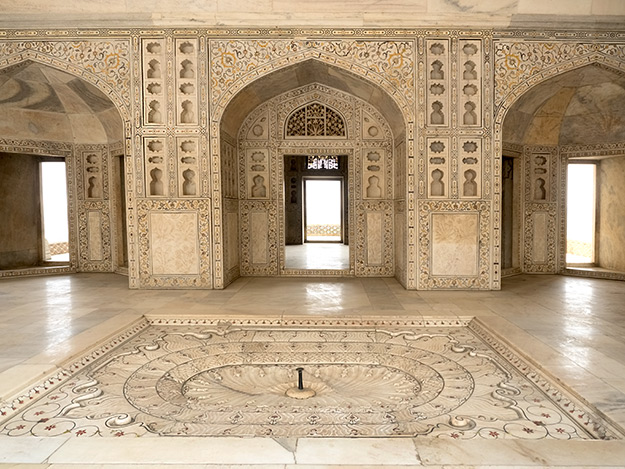
Most beautiful in my eyes, however, was Diwan-i-Am, or the Hall of Public Audience. This was where the Emperor heard grievances brought before the court. The open-air platform is supported by rows of columns joined by graceful scalloped arches. From a distance, it is reminiscent of a giant rectangular wedding cake. From within, the columns and scalloped arches stretch to infinity, growing smaller with distance and creating the illusion of endless reflections in a mirror.
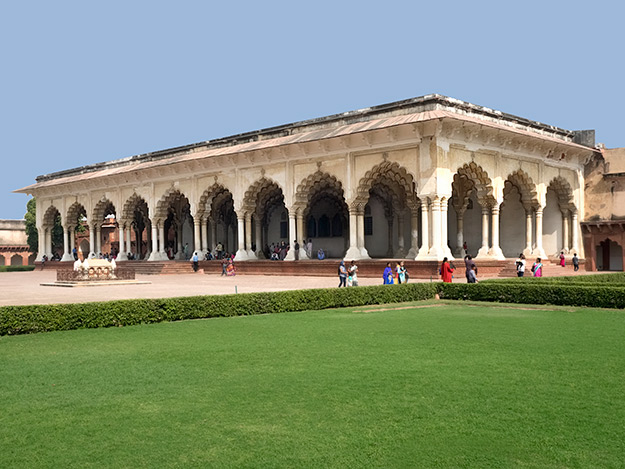
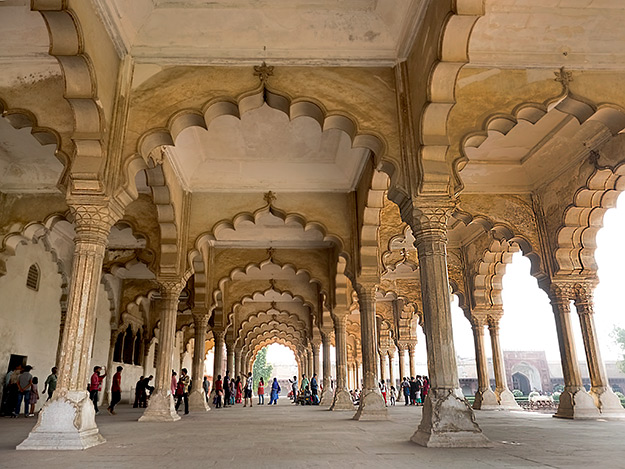
Fatehpur Sikri:
In 1571, Emperor Akhbar began constructing a new Imperial City, Fatehpur Sikri, on a site located approximately 24 miles from Agra. The complex is bounded on three sides by 3.7-mile walls that are fortified by towers and pierced by 9 gates. Unlike Agra Fort, which was intended solely for members of the court, Fatephur Sikri was the first planned city of the Mughals. It included not only palaces and mosques, but also administrative buildings and residential areas for the court, the army, servants, and commoners. The city was abandoned in 1585, when the spring-fed lake that supplied the city with water dried up.
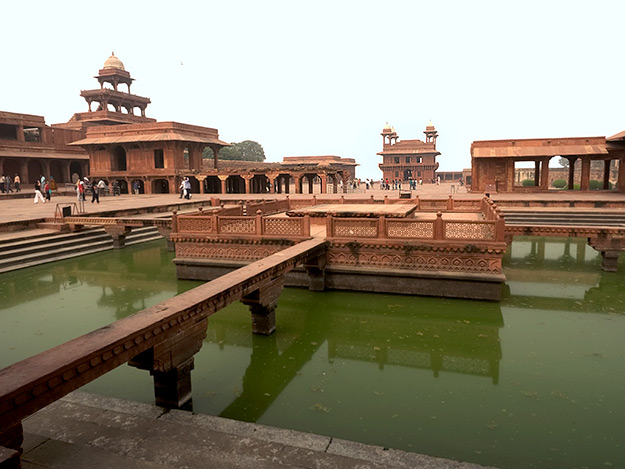
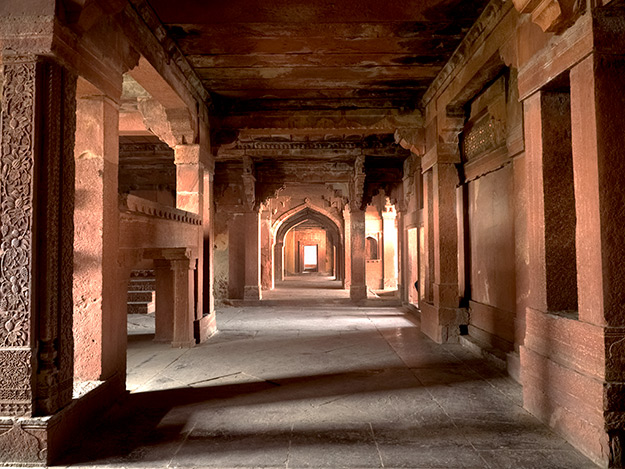
Considering its short existence, the architecture at Fatephur Sikri is nothing less than astounding. Notable structures within the walls include Fatephur Sikri Palace; the Imperial residential complex; the Treasury; and Jodh Bai’s Kitchen, the outer walls of which are entirely covered with geometric, floral, and mat designs. But without a doubt, the crown jewel is the aptly named Jewel House. Unique in the range of Indo-Islamic architecture, it consists of a single vaulted chamber, open from floor to roof. In the center stands a profusely carved column, topped by a colossal bracketed capital.
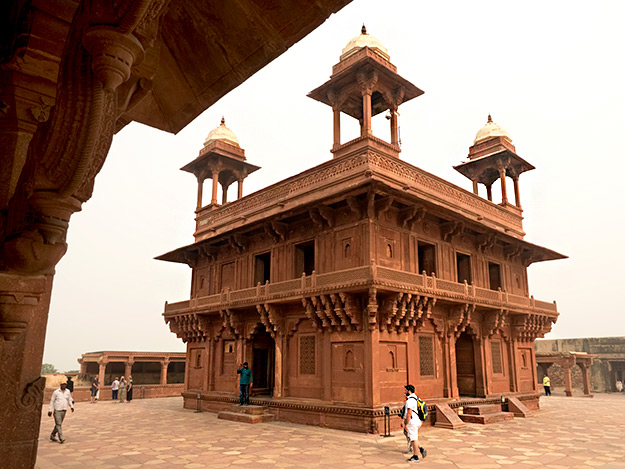
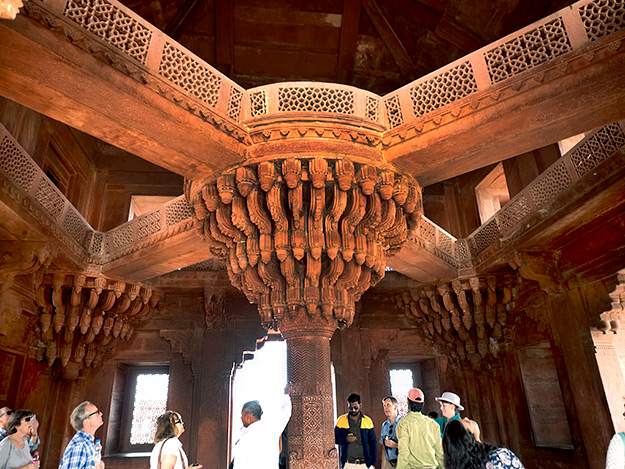
Adjacent to the old city but outside its walls stands Jama Masjid, one of the largest mosques in India. Unlike the Imperial City, which is no longer occupied, the mosque is still an active site of worship. It was the greatest monumental structure built during Akbar’s reign and is still considered one of the most perfect architectural achievements in India.
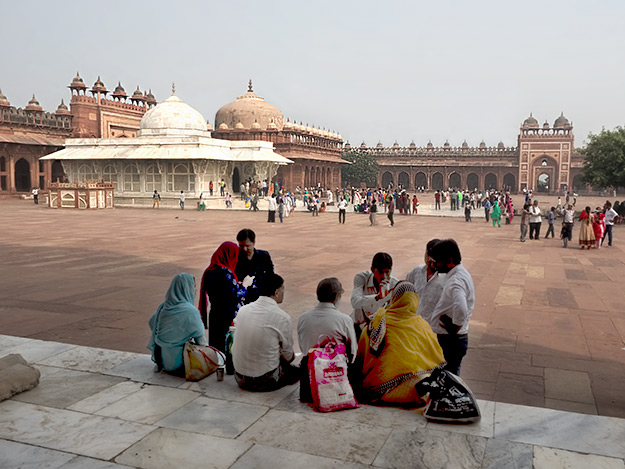
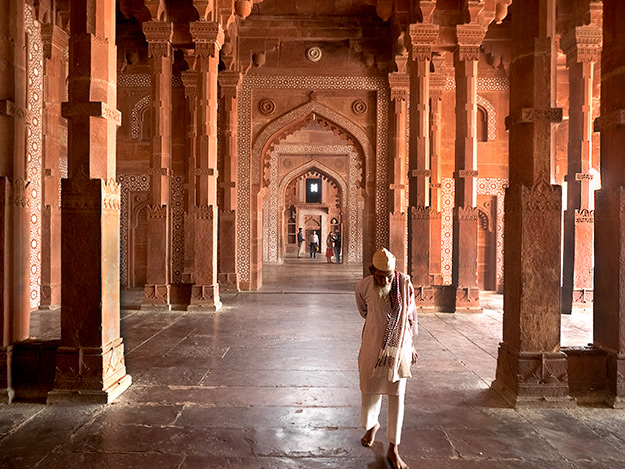
My scheduled time in Agra was rapidly drawing to a close, but for every sight I visited, two new ones presented themselves. Without a second thought, I extended my stay for an additional three days. At the top of unique things to do in Agra was Itimad-ud-daulah. Built entirely of white marble and inlaid with semi-precious stones, this mausoleum on the banks of the Yamuna River exhibits a strong Persian influence. Because it so strongly resembles the Taj Mahal, it is also known as the Baby Taj.

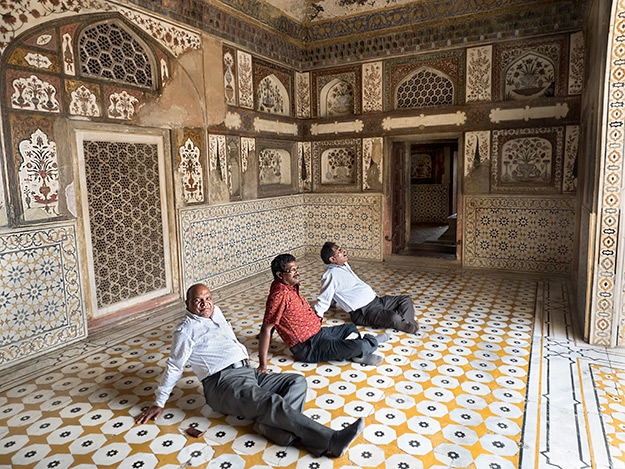
Less than two miles from the Baby Taj I strolled through Mehtab Bagh, a shady quadrilateral garden divided into four smaller parts by walkways and flowing water. Recent excavations at the site have revealed the ruins of octagonal water tanks, 25 fountains, and a series of ancient pavilions. These are likely the ruins of the “moonlit pleasure garden” that Emperor Shah Jahan had constructed on a grass-covered floodplain across the Yamuna River, which was as an ideal location for viewing the Taj Mahal. Today it may still be the best place from which to view the Taj Mahal; certainly is is the only way to see it without suffering the crowds.
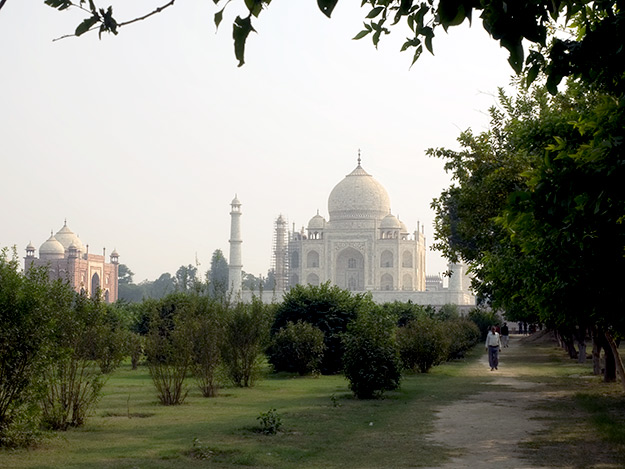
On my final day in Agra, I perused the list of historic sites I had yet to visit. Chini Ka Roza, a mausoleum for the Persian poet Afzal Khan builtin 1635, is known for its fine ceramic tiles. Ram Bagh gardens, was laid out by Emperor Babur, founder of the Mughal dynasty. Sikandra, the 1613 mausoleum of Emperor Akbar combines the best of Hindu and Muslim architecture. The red sandstone Mariyam’s Tomb was built in honor of Emperor Akbar’s wife, Mariyam Zamani.
I was, however, a bit “templed-out” by then, so I opted for an entirely different type of experience. I hired a guide to take me on a tour of the Old Market, where each evening wholesalers auction off merchandise in bulk quantities. First up was the wholesale spice market. Under the watchful gaze of monkeys who skittered around the rooftop, we threaded between overstuffed burlap sacks. I closed my eyes and breathed deeply. The air was redolent with chilies, saffron, jeera, masala, and a dozen more scents I couldn’t identify.

Around the corner we joined an auction of the betel leaves that are used in the preparation of paan. The leaves are spread with slake lime, sprinkled with tobacco, and wrapped around an areca nut. When chewed, the concoction produces a slight psychoactive effect, and the teeth of those who become addicted eventually turn bright red. The competition was strenuous but good-natured; bidders smiled and invited me into the fray to take photos.
Our final stop was at a 175-year old family run shop that sells wholesale wedding supplies and festival decorations. Three generations were represented by the men who sat cross-legged among the decorations. Even though I was not a potential customer, they eagerly explained the uses for the various items that lined their walls. Curious, I asked about two young men in the rear who were trying on elaborate silk turbans. With a huge grin, the owner plucked one off the wall and set it on my head.

As I posed for photos against a wall hung with rainbow silk and floral garlands, he explained that grooms wear the turbans on their wedding day. Laughing, I handed it back. I’m not likely to get married, but I appreciated the opportunity to learn more about the culture of India, and to experience some of the many things to do and places to visit in Agra, beyond the Taj Mahal.

What does the hole in agra fort depict
India is one of the most well known Tourist Country. You will see art at every corner of India.
Barbara if you want to visit India again you can contact Kesari Tours, which will help you to get the more information about tourist place in India.
Thank you, Surya.
You forgot to Visit Vrindavan !!!!!!
I’ll put it on my list, Harvinder 🙂
Taj Mahal Beauty touched me so much. I love to be here again and again. And yeah, you are looking super cool with that turban.
LOL – not sure I would have said “super cool” but the owners of that shop were so kind and happy.
Barbara, Your blog and Facebooks posts inspired us to visit the Red Fort when we visited Agra. I finally got my blog up. In my Agra overview blog, I want to talk about other things to do in Agra. Are you ok if I reference this blog? Thanks. Linda
Thank you so much, Linda. Makes me happy to hear you like my blog and that I could be of some help. Please feel free to link to my blog whenever you like. In fact, there is no need to ask ANY blogger for permission to do this. I can assure you that we love linkbacks.
Taj Mahal is beautiful to look at, but it looses its charm when you think it took 22 years at he cost of 22,000 slaves.
I found the other places much more to my liking, though slaves may have been used there too…
Cheers,
Walter
Thanks Walter. As so often happens, I also found the very hyped Taj Mahal to be the least of the sites I visited in Agra.
I’m so surprised you said that! I was just there. I was blown away by the beauty of the Taj Mahal. I actually got a little emotional. My time at Fatehpur Sikri was diminished by the aggressiveness of the touts on the approach, at the mosque, outside, etc. I enjoyed Agra Fort. My hotel, a 10-minute walk from the Taj was great. But nothing prepared me for the beauty of the Taj Mahal. Along with my stay in Rishikesh, it was the highlight of my trip to India.
Hi Billy. I didn’t say that I didn’t like the Taj Mahal. I only said it wasn’t the only interesting site in Agra, and that many of the others are much less crowded and thus more enjoyable. The more you travel, the less the touts will bather you. You will learn how to just shrug them off or avoid them by not making eye contact.
I’m looking forward to a long trip through India, so once again you’re prepping me for the visit. this was great. Thanks, Barbara.
You’re welcome Kate! Glad you found my stories useful. I’ll look forward to reading your accounts after you travel to India.
Stunning all that beautiful architecture. Amazing culture.
Hi Peter: It is stunning, in every way, and the culture, well, what can I say. It makes me so grateful for what I have.
Wonderful commentary and photos. Enjoying our recent trip again as you “take us back” thru your writing and photos.
Thanks so much Mark!
Great , Nice to see that you had a great time in Agra , Always welcome back,
Thank you Moses. There is so much more of India that I want to see that it’s not likely I’ll come back to Agra soon. But I appreciate your welcome back 🙂